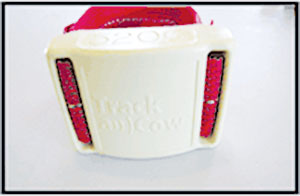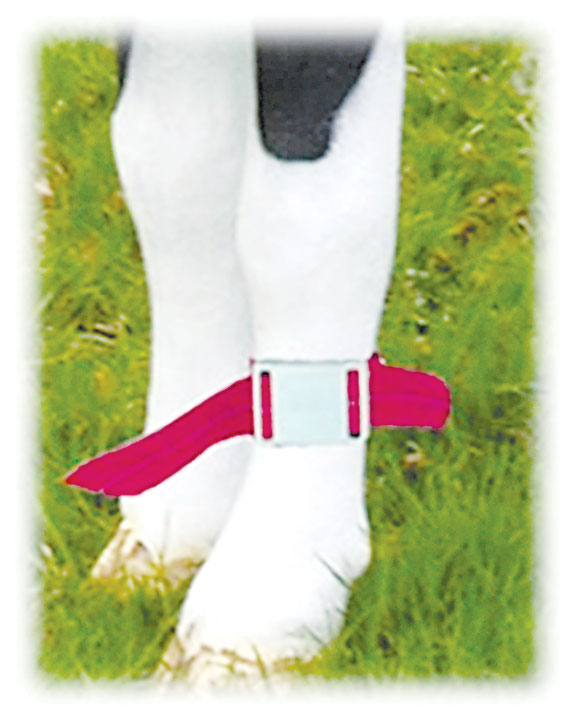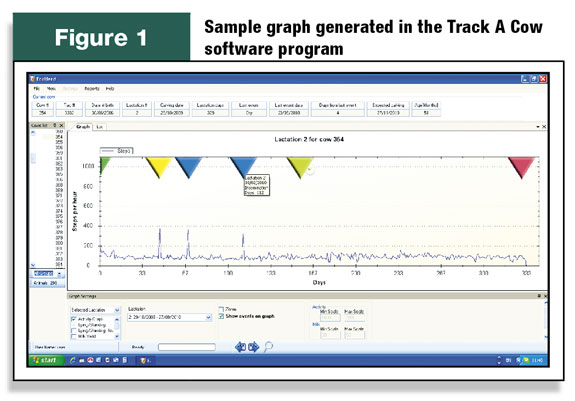The following is the second article in a series about different activity monitoring systems currently being used on dairy operations. Click here to read the first article in the series, "Activity monitoring system researcher: ‘This is the right way’"
A reduction in the use of hormones to synchronize breeding times on dairy operations is a trend that has developed in countries around the world, though due to hard-to-breed cows and cystic cows, there will always be a need for some hormone usage.
Although the use of hormones in breeding programs in the U.S. is still widely practiced, other alternatives such as activity monitoring systems are becoming more commonplace on dairy operations across the country.

In February, animal health products supplier Animart, based out of Beaver Dam, Wisconsin, was approached by a company in Israel about becoming a distributor for the Legend Heat Detection System, a pedometer-based activity monitoring system.
This pedometer is already in use in dairy operations in Israel, Europe, South America, China and Canada.
Armon Hetzel, one of Animart’s professional services veterinarians, met with the product developers and shared how the system works and how dairy producers in the U.S. could benefit from using this system.
He says these pedometers demonstrated versatility in the information that could be obtained. He also points out that this pedometer is the smallest tag in electronic heat detection systems and the only long-range leg tag.

Legend Heat Detection System
The purpose of the Legend Heat Detection System is to evaluate the increased activity of cows to help the dairy producer make timely decisions regarding artificial insemination.
The system also serves as a tool to assess a cow’s activity and how it relates to overall animal health.
“The end result of using this product is to increase a dairy producer’s profitability by reducing the amount of reproductive drugs used in breeding programs and lowering services per conception while increasing conception rates and pregnancy rates,” Hetzel says.
In order to do this, the system requires the use of three main components: the pedometer; a receiving system (which consists of antennas, a receiver and a connection box); and the software program.
The system collects and transmits cow activity data in real-time via an antenna and receiver to the software program. The data from the pedometer is transmitted through radio frequency, which is picked up by antennas.
The antennas transfer the data to a receiver, which will then send that information to a connection box or com card.
The com card organizes the data, transfers it to the computer and finally to the Legend Track a Cow software program.
The system has two antennas available – the WIP antenna and the Yagi antenna. The WIP antenna is mostly frequently used in dairy operations because it covers a 450-foot radius in all directions.
The Yagi antenna is a directional antenna that fans out in a triangular pattern with a range of 1,800 feet. This antenna is mainly used in beef herds or pastured dairy cattle rather than conventional freestall barns.
Time lapses
“Because the system is hardwired to the computer, additional monitors or readers are not necessary,” Hetzel says.
Hetzel illustrates an example of how easily a heat activity spike could be missed when cows must pass by a reader to have data transmitted.
“Let’s say a cow leaving the parlor goes by a reader and at that moment she doesn’t show high activity, but then has a spike in activity 15 minutes later,” Hetzel says. “That spike would probably go unnoticed until eight hours later or even longer, depending on when she returns to the parlor.”
This system’s tag collects and transmits data in real-time, every six to seven minutes, which is different from other activity monitoring systems that update every two hours. This allows for in-heat events to be detected in a quicker manner.
Once the high-resolution data reaches the software program, it can be analyzed to generate different lists and graphs depending on what reports the producer wants to look at, Hetzel says.
This information can include cows ready for service, increased activity, lying-to-standing ratios and inactive pedometers. This information can be monitored over the entire lactation of a cow.“Our reports are concise and detailed down to the minute she spiked,” Hetzel says. “It’s very easy to train people on what they need to get out of it.”

Figure 1 is an example of a graph generated in the Track A Cow software program. The graph screen shot represents the reproduction record of a cow over one lactation.
The three spikes indicate a heat activity spike. The yellow arrow above the first spike indicates the cow was not bred.The two purple arrows indicate an insemination and the green arrow indicates a confirmed pregnancy. The red arrow at the end indicates the cow being dried off.
Trial run
The system was first installed on a Wisconsin dairy in June. Results from that trial yielded conception rates of this activity monitoring system being double that of Ovsynch. In the first round of pregnancy checks, this system had conception rates of 43 percent while Ovsynch was at 20 percent.
Although the second round of pregnancy checks took place during a period of hot weather, conception rates for Legend again doubled those of Ovsynch, with 20 percent compared to 10 percent.
“The dairy owner told me that he sees the savings in the amount of drugs that he uses even on this limited trial basis and saw the value of having a system like this one in place,” says Hetzel.
Managing your cows
When Hetzel goes out to a dairy considering using this technology, he first identifies the location of the breeding pen, the amount of cows in the pen that are breeding-eligible and the number of pedometers planned for use.
On the trial dairy, after a cow was confirmed pregnant on the second pregnancy check at around 62 to 67 days, the pedometer was removed. The cow’s number was then deleted from the pedometer and replaced with another cow’s number.
“Instead of putting a pedometer on every cow in the herd, the dairy producer put them on about half of the cows and rotated the pedometers around,” Hetzel says.
He states that this decision was justified based on the dairy’s past records, which showed only 1 to 1.5 percent of the cows turning up open after the 67-day pregnancy check.
Hetzel explains that if a dairyman expands his herd, more antennas and receivers would be required because one antenna and receiver can manage up to 250 cows. They could then simply be linked to the ones already in place.
In a big operation, additional com cards would be needed as well, because each com card has the capacity to organize data for 1,500 pedometers.
“For example, if a producer wanted to put a pedometer on every cow in a 6,000-cow herd, four com cards would be needed to organize the data,” Hetzel says.
Challenges
Hetzel explains the challenges facing this system stem from a lack of awareness among dairy producers about how the system works compared to their current reproduction programs. He states that it will take some adjustment by herd managers and dairymen to trust the system and switch to it from other programs, such as those that follow Ovsynch protocols.
“We had learning curves at the beginning,” Hetzel says, when discussing backup systems.
Early on, the Animart team learned that the computer linked to the system must be backed up on a regular schedule. Hetzel says a battery backup system for the desktop computer is necessary to avoid data loss. Using a laptop computer is preferable to desktop computers to avoid a complete power-off.
He explains that if proper backup systems are in place, there should not be any problems. An uninterrupted power source should be part of the system’s installment.
Hetzel makes sure to back up the system on the trial dairy every day and explains that these backups can be made from remote locations. Additional technical support can also be provided for these systems remotely.
For example, if there is a problem with the system, a technician offsite can log on to the system and fix the problem.
“That support is pretty valuable,” Hetzel adds.
Hetzel explains that giving estimates on the cost of implementing this technology is not an easy or quick process, because every dairy producer’s situation is different.
In order to assess costs, he requests information such as the dimensions of the barn, the location of breeding pens, the amount of hard cable needed to wire the system up and the number of pedometers the dairy will need. Hetzel says a lot of this he can do through e-mail, phone and fax.
“Because it’s so versatile, a 1,000-cow herd may only need to order 500 pedometers, which makes a big difference right away,” Hetzel says.
Advantages
Hetzel explains that in Israel, batteries with this technology commonly last from 20 to 25 years because the battery is completely sealed and the radio frequency doesn’t require a lot of energy.
If the pedometer is defective, the pedometer will be replaced at no cost for the first year, which is then followed by a five-year regressive warranty.
Additionally, the software program can pull up a list of pedometers that are inactive or not transmitting information. The list identifies the number of the pedometer, and if it is on a cow, it will pull up the cow’s number as well.
Another advantage of this heat detection system lies in its ability to compute a cow’s lying-to-standing ratio. Within the program, the lying-to-standing ratio can be selected from a drop-down menu, which will then provide a list of cows standing or lying excessively.
“At first, I wasn’t sure how this was possible, so I inquired,” Hetzel says. “I found out that when that pedometer is tipped 30 degrees in any direction, there’s a sensor inside that will note that.”
Hetzel explains that cows standing up will not tip the pedometer 30 degrees even when they are walking. The reason these ratios are important is because they can see which cows are either standing or lying for longer periods of time than normal.
This information can alert producers about cows that show decreased activity, helping to identify illness or lameness. “It is a huge advantage to be able to identify these issues before they develop into more severe cases,” Hetzel says.
Goals
One of Hetzel’s main goals for the Legend system is to link it with a mainstream dairy management software program. “I think that’s probably the most important thing we do,” he says.
“All we have to do is get our system to sync with these dairy records software programs for the data entry part,” Hetzel says.
Animart is currently working with dairy herd management software companies to build an interface for this system.
“I spent a lot of time going through the program on the different things that you can find and get out of it,” Hetzel says. “It has been pretty neat, and I have not been disappointed on what this system can do.” PD

-
Dario Martinez
- Editor
- Progressive Dairyman magazine
- Email an editor






